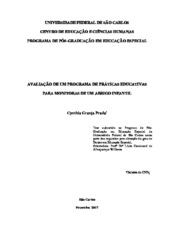Avaliação de um programa de práticas educativas para monitoras de um abrigo infantil
Abstract
In the last few decades, it seems to be increasing the number of families who find
difficulties to educate its children. The most frequent parents concerns are: the difficulty of
establishing limits to the behavior of the child or adolescent; how to develop behaviors that
they believe to be right; and how to proceed when behaviors problems appears. These
difficulties do not restrict to the universe of the families who take care of its own children,
but they are also focus of concern on institutions that foster care children victims of
domestic violence and those caregivers. The lack of preparation of parents, educators or
caregivers of institutions, many times may develop or aggravate problems of development
and behavior of these children. For this reason, this study had the aim to develop,
implement and evaluate a program of intervention with caregivers that work with sheltered
children who had been victims of domestic violence, in order to present a reference on
Educative practices, preventing or reducing possible behavior problems of these children.
To evaluate the effectiveness of the intervention program, evaluations had been applied
before the beginning (pre-test) of the intervention program and soon after its ending (postest),
using the following instruments: IEP - Inventory of Educative Practices, CBCL -
Child Behavior Checklist and the Script of interview of life and professional background
of the caregivers. Also were collected continuous measures of the Interaction between the
caregivers and the children in 19 sessions, defined as 3 of base line, 12 taken three days
after each Intervention session and 4 of follow-up, applied five months after the ending of
the intervention. The results demonstrated a significant reduction of the negative educative
practices, mainly in Relaxed Disciplines and Negative Monitoring, with high scores at the
pre-test, as well an increase of the positive educative practices. The evaluation using the
CBCL demonstrated that the children had presented statistical significant behavior
improvement. The continuous measures data had indicated an increase of positive
interaction behaviors between caregivers and children, as well a reduction of negative
interaction behaviors, and the most significant outcome was that the measured frequencies
of good behaviors in follow-up sessions did not return to the measured levels of the base
line. The considered intervention program presented can be considered efficient to generate
changes in the interaction standards between caregivers and children; however it would
need to be applied in different institutions to assure the applicability in distinct
environments.
